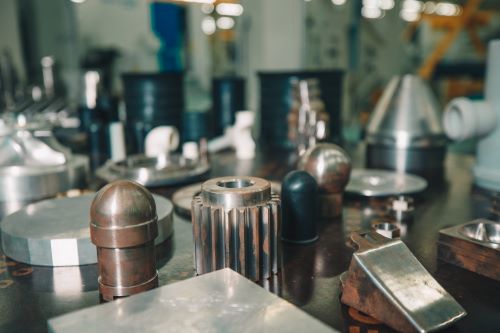
In the changing industrial manufacturing environment, no sector has changed as technologically as die casting. Of these, the function of a contemporary Aluminum High-Pressure Die Casting Parts Manufacturer has become ever more pivotal to those sectors that need lightweight, sophisticated, and durable metal components. From automotive and aerospace to electronics and heavy machinery, aluminum high-pressure die casting (HPDC) provides the precision, speed, and economies of scale to satisfy the demanding production demands of the time.
At the center of it all is molten aluminum and high-pressure injection, where metal is forced into a steel mold cavity as fast as 100 meters per second. That rapid, high-pressure filling—typically over 20,000 psi—is what makes parts made with very high detail and low porosity. That’s good news for the manufacturers, as that allows them to produce high-integrity parts that integrate functional features such as bolt holes, mounting brackets, and heat sinks into one continuous process.
One of the strongest competencies of a contemporary aluminum high-pressure die-casting parts producer is its capability to produce highly complicated components with uniform repetition. Sophisticated computer-aided design (CAD) and simulation technology enable manufacturers to manufacture molds that encompass large quantities of geometry and function elements—e.g., bosses, ribs, and bolt features—without additional secondary machining.
This integration of operations saves assembly time and expense considerably. Rather than making a base part and subsequently drilling bolt holes or welding mounts, for example, manufacturers may be casting all these details into the part as they do die casting operations. This leaves them with tougher parts having tighter tolerances and less chance for mating mistakes on final assembly.
Speed and Volume with Quality
Mass production is another sector where these manufacturers excel. A high-tech aluminum high-pressure die casting parts manufacturer employs fully automatic casting cells equipped with robot arms, high-speed injection machines, and real-time monitoring systems. These technologies allow mass production of thousands of identical parts in hours, which is perfect for the automotive industry, where every engine block, bracket, or bolt-connected housing must be produced in quantity.
Moreover, speed is not compromised at the cost of quality. Contemporary manufacturers employ advanced quality control systems, including real-time X-ray inspection, pressure testing, and dimension scanning, in order to guarantee that all components adhere to stringent standards. The capability to manufacture mass quantities of bolt-compatible components with high-tolerance threads guarantees reliability and performance over time in critical applications.
Lightweighting and Material Optimization
Aluminum is the industry favorite for its strength-to-weight ratio, corrosion resistance, and thermal conductivity. HPDC producers are masters at optimizing aluminum alloys for particular uses, trading off such properties as ductility, hardness, and finish.
For example, in car structures where each bolt should bear the load effectively without contributing to added weight, cast aluminum parts bring about a noticeable edge. The components are crafted to be heavy-duty where they are needed to be so, close to load-carrying details such as bolt flanges, and lighter where not essential, thereby working toward overall product performance and design efficacy.
GMHitech: Innovation in Motion
One of the prominent aluminum high-pressure die casting parts manufacturers is GMHitech. It is renowned for focusing on state-of-the-art production, and GMHitech is one of the companies that deals with the production of cutting-edge aluminum die-cast parts used in the automotive, industrial, and electronics sectors. The company has the complete set of cutting-edge capabilities, ranging from mold simulation and prototype build to automated casting and final inspection.
GMHitech’s capability to combine threaded bolt holes, bespoke brackets, and high-strength ribs in its die-cast products demonstrates the harmony of design and production. Clients can enjoy fewer process steps, shorter lead times, and longer product lifespans, all without breaking the bank. This is the future direction of die casting: intelligent, efficient, and uncompromised quality.
Surface Finishing and Post-Processing
In addition to the casting itself, a contemporary aluminum high-pressure die-casting parts producer provides various finishing operations that impart function and aesthetic characteristics to the product. Surface finishes like powder coating, anodizing, and chromating are often used in order to provide corrosion protection and a cosmetic look.
Some of the features that are particularly those that will be linked to mechanical fasteners, such as bolts, are precision machined to ensure perfect thread fitment and alignment. The interplay between die casting and finishing capacity enables organizations to supply parts ready for use that meet or exceed the required standard, lowering the chances of having to adjust on the side of the customer or rework.
Sustainability and Waste Reduction
Green sustainability increasingly becomes a factor in production, and aluminum die casting is well-positioned to address this. New producers use closed-loop recycling procedures for aluminum, where scrap metal and faulty components are melted and reused in subsequent castings. This not only avoids waste but also lowers the material cost.
When bolt holes, structural supports, and other design features are cast right into the molding, there is no secondary machining needed, and with it, the accompanying energy and resource usage. This green, efficient manufacturing process saves both manufacturers and customers with top-quality parts and reduced environmental impact.
Conclusion
The potential of a contemporary aluminum high-pressure die-casting parts manufacturer is far greater than mere metal casting. Through technology adoption, accuracy, and extensive knowledge of industry needs, the manufacturers offer end-to-end solutions that facilitate quicker production, uniform quality, and low cost.
Regardless of whether it’s incorporating bolt features into intricate part geometries, realizing best-in-class material efficiency, or high-volume manufacturing at competitive costs, die-casting experts these days are invaluable collaborators in contemporary manufacturing. Organizations such as GMHitech demonstrate the triumph when innovative technology and mastery of craftsmanship unite—providing performance, dependability, and value in each casted component.







